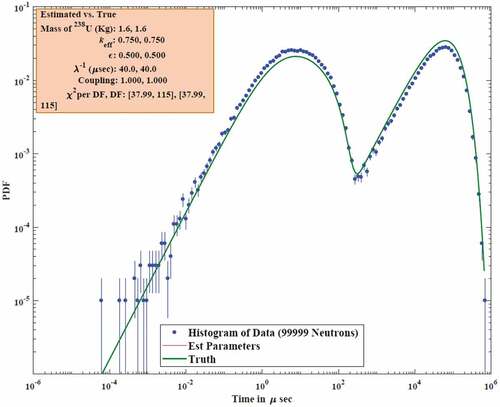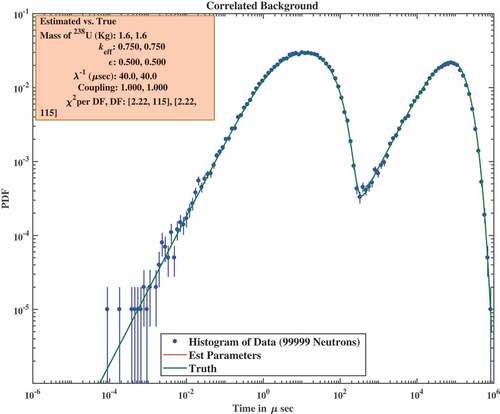 ?Mathematical formulae have been encoded as MathML and are displayed in this HTML version using MathJax in order to improve their display. Uncheck the box to turn MathJax off. This feature requires Javascript. Click on a formula to zoom.
?Mathematical formulae have been encoded as MathML and are displayed in this HTML version using MathJax in order to improve their display. Uncheck the box to turn MathJax off. This feature requires Javascript. Click on a formula to zoom.Abstract
Very careful examination indicated that two key formulas in our paper “Neutron Time Interval Distributions with Background Neutrons”1 had errors. We revise here the derivation and results for the probability to obtain a count between and
following a trigger count when the neutrons come both from fission chains and either correlated backgrounds or an external random source, Eqs. (76) and (79) (Ref. 1).
I. INTRODUCTION
A more careful comparison between Monte Carlo simulations and our key equation for the probability to obtain a count between and
following a trigger count when the neutrons arise from both fission chains and correlated (air shower) backgrounds, Eq. (76), or fission chains and an external random source, Eq. (79), shows those formulas are not exactly correct.Citation1 The discrepancy between simulated data with correlated backgrounds and Eq. (76) is shown in . Our corrected formula, EquationEq. (6)
, shows much better agreement in .
Fig. 1. The discrepancy in Eq. (76) (CitationRef. 1) becomes obvious with high detection efficiency, in this example. Correlated backgrounds were simulated in this example as an external
Cf source
g in size with a 40-
s diffusion time (characteristic of
He-based neutron multiplicity counters) and a background neutron detection efficiency of 30%

Fig. 2. Data for the same configuration as in compared to EquationEq. (6)

The discrepancies are in the last two terms of both Eqs. (76) and (79) in CitationRef. 1. The derivation that gives the correct formulas follows from the relations that connect the time interval probability distribution, , to the probability to count zero neutrons within a random time gate of duration
,
—Eqs. (23) and (30) in CitationRef. 2:
where
is the probability to count zero neutrons within a time gate of duration following a trigger count. This relation turns out to be very general.
II. FISSION CHAINS COMBINED WITH CORRELATED BACKGROUNDS
In the next-to-last term of Eq. (76), which describes the probability when the trigger count is from an air shower and the next count is from a fission chain, the triggered time gate probability in that formula should be replaced by the corresponding random time gate probability
. In the last term, which describes the same process in the opposite order (the probability when the first count is from a fission chain and the next count is from an air shower), the triggered time gate fission chain probability
in that formula should be replaced by the corresponding random time gate probability
.
The starting point when correlated backgrounds are included is . The relations are
and
The derivatives give
Differentiating this triggered counting distribution, the time interval distribution becomes
where and
are Eqs. (70) and (73) (CitationRef. 1). This formula gives the corrected version of Eq. (76) (CitationRef. 1).
Because of the derivative relation between these distributions, the normalization of the time interval probability distribution follows simply:
This can easily be seen because, after a trigger count, the probability of getting zero counts in an infinite amount of time is zero and the probability of getting zero counts in zero time
is 1.
III. FISSION CHAINS COMBINED WITH AN EXTERNAL RANDOM SOURCE
The formula for random background is obtained from this formula using the relations
and
The time interval probability distribution for fission chain counting in the presence of an external random source is
where is Eq. (70) (CitationRef. 1). This formula gives the corrected version of Eq. (79) (CitationRef. 1).
Acknowledgments
We would like to thank Hema Chandrasekaran for identifying the errors in Eqs. (76) and (79) (CitationRef. 1) and for confirming the correct formulas, EquationEqs. (6) and Equation(10)
(10)
(10) above.
A draft of this addendum has Lawrence Livermore National Laboratory (LLNL) document number LLNL-JRNL-757644. This work was performed under the auspices of the U.S. Department of Energy by LLNL under contract DE-AC52-07NA27344. This work was supported by the U.S. Defense Threat Reduction Agency under DTRA10027-10273.
References
- M. PRASAD, N. SNYDERMAN, and S. WALSTON, “Neutron Time Interval Distributions with Background Neutrons,” Nucl. Sci. Eng., 186, 277 (2017); https://doi.org/10.1080/00295639.2016.1273620.
- M. K. PRASAD et al., “Time Interval Distributions and the Rossi Correlation Function,” Nucl. Sci. Eng., 174, 1 (2013); https://doi.org/10.13182/NSE11-87.
